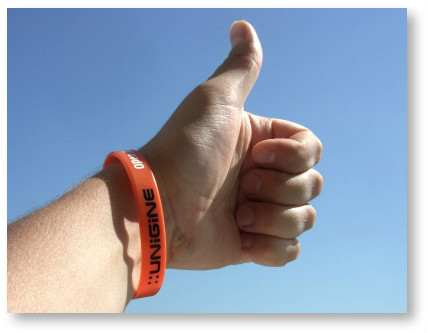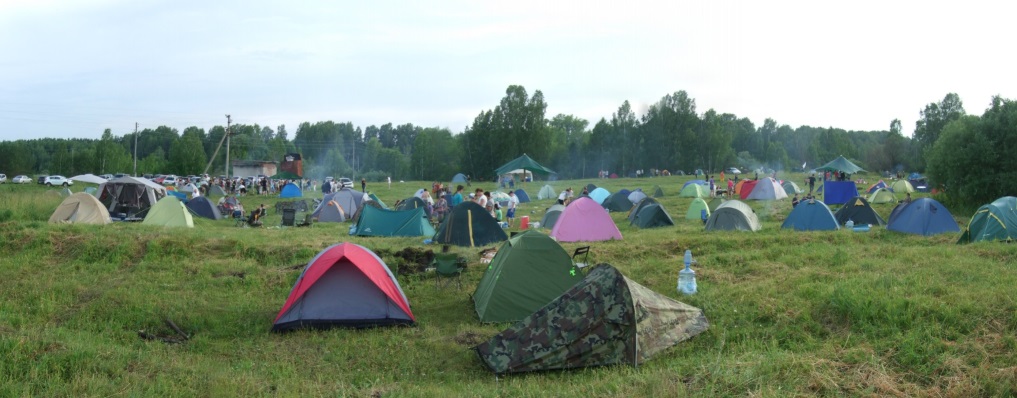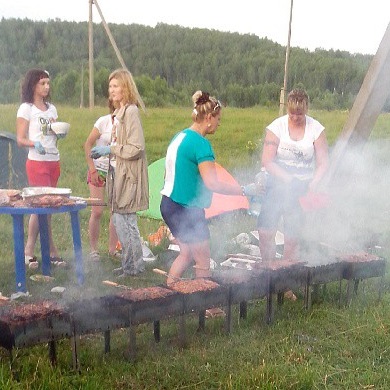Unigine Open Air 2013. How it was (a look of one development)

Hello!
Last weekend, one of the most unusual IT conferences I was able to attend was held near Tomsk.
If you do not see yourself without communicating with your own kind, you like rest, tents, night coding shaders, game engines, C ++ hardcore optimization, games, intimate conversations about LLVM and Flash under thunder, beautiful girls in bathing suits able to build a build on 7 platforms in one click - well under the cat, there is about how it was.
Who are all these people?
It all started back at CodeFest 2013 - the Unigine team under the leadership of Denis Shergin, megapositive and knowledgeable about their business, told about a severe Siberian 3D engine that has been surfing the world for more than a year and is one of the notable products not only in Siberia, but worldwide. The guys have a lot of experience, a well-coordinated, surprisingly small team, a high-class product, a bright look into the future, and, most importantly, a great desire to share experiences, learn and unite people in this industry. Between the reports was a small flat, where, in addition to discussing the pressing problems of 3D developers, Unigine Open Air was announced - an IT-conf about game decks in nature, to which they invited everyone.
')
Summer came, the registration for Unigine Open Air 2013 solemnly opened, having run through the program, there was absolutely no doubt - to definitely go!
The first day
July 20, point B is located 300 km from Novosibirsk, the navigator cheerfully paves the road to Tomsk, a turn, another one ends asphalt, a kilometer along the gravel and here it is - the cherished glade. Most of the participants are already in place, they unfold tents, dig holes for fires, the sun burns a little, D'n'B plays light, happiness!

The organizers approached responsibly - the territory was tick-borne, a lot of drinking water, security, toilets - nothing to complain about.
Denis Shergin opened the event binstream with a story about 3D on the fingers. Who are the vertices, edgy, polygons, texels, how to stretch the texture, get the normal and display it all on your 2D monitor. Interestingly, lively, for beginners the most it!
By the way, at first a strong wind was blowing, and this friend helped with all his strength to keep the flipchart (details in the comments, if you're interested):
Show hero

Alexander Pogrebnyak apogrebnyak continued the educational event with a story about technologies in the development of modern kazualok. Who needs statistics and why, how to attract an audience, what tools are used for this, why and why leaderboards work, the social component of any project, how to make game development fast, cross-platform and with minimal risks for all. In 90% of cases, this kitchen is not used in projects that go without a publisher, which negates almost all the chances of success, although it is necessary, important and almost half of success. Vacationers colleagues vividly interested in the details, of which there was enough.
After a small dinner, a small tent was found, where, what would you think? There was a demo platform with a real Oculus Rift! The Unigine engine already supports this thing!

Friends, this is awesome. The developer version is slightly upset by the low resolution, but everything else just drives any 3D cinema by several orders of magnitude. I sincerely sympathize with all those who for some reason could not test this thing there on the spot. It’s like a trip to the future, with a clear awareness that this future is no longer the future, and will be available with chic quality in the next couple of years. Another one was a PS3, where everyone could chop into Mortal Kombat in order to reboot their brains before the next mega-cognitive report.
The next exporter was Pavel Nakaznenko, who spoke in great detail about all the pain and joy of porting the Unreal Engine 3 to Flash using FlasCC technology. Just at that time a severe downpour began and the whole action quickly moved under the tent. Here we learned how to emulate UDP over TCP (aha), how in theory you can do a peer-to-peer via RTMP (somewhere there was the loudest thunderclap, I think he understood something), how many flush flow conditions, how many memory and hours need to rebuild the project, what pitfalls were, what are now and what the prospect of the whole technology in general. Already, the project is in open source , has a good future in the form of a transition to Clang, and in general, the devil is not so bad as they say. Doubters, it is already possible to sausage, everything works there (we also have a positive experience with FlasCC).
Without being distracted for a long time, he himself took the stage ... ... Alexander Frustum Zapryagayev! I do not know about you, but in my humble little world this uncle is on a par with John Carmack .
About Alexander
Kindly taken from here .
The same Frustum . Its code is used in hundreds of 3D projects around the world. Creator of UNIGINE Engine . 14 years in programming, has written over a million lines of debugged and highly optimized code for Windows, Linux, Mac OS X, PlayStation 3, Android, iOS and WinRT.
Since childhood, fond of technology: mechanics, electronics. He disassembled everything he could and assembled quite complex devices from scratch.
He began intensively programming in 1999, having completely independently mastered Computer Science (Alexander is a radio physicist by training).
Created various programs - from the dictionary to the operating system prototype for different platforms (including embedded ones).
Inspired by 3D graphics, Alexander wrote over 50 cross-platform (Windows / Linux) demos that are publicly available on his personal website frustum.org .
Since almost all of them differed in highly optimized, high-quality and understandable code, these demos have become 3D graphics tutorials for many programmers around the world.
Already during this period, representatives of NVIDIA and ATI noticed his work.
In 2002-2003, Alexander worked at the German company VRtainment: he dealt with issues of 3D graphics and physics simulation.
In 2004, Alexander decided to start developing his 3D engine, which became the main product of the company, which he founded together with Denis Shergin in 2005.
Alexander is a leading developer of UNIGINE Engine , he is well versed in all issues related to interactive real-time 3D applications: graphics, physics, sound, resource management, GUI, scripts ...
In addition, he is the author of his own programming language UnigineScript.
Based on Alexander's code, the company released a series of graphic benchmarks ( Sanctuary , Tropics , Heaven , Valley ), used by millions of people, and the strategic game Oil Rush .
Alexander's works were published in the popular ShaderX - Advanced Rendering Techniques book series, demonstrated at leading trade shows (GDC, SIGGRAPH, ITEC), in 2012 he spoke at SIGGRAPH (the most authoritative conference on computer graphics on the planet).
Now Alexander is the technical director of the UNIGINE company and continues to write a lot of code, simultaneously managing the development team.
The same Frustum . Its code is used in hundreds of 3D projects around the world. Creator of UNIGINE Engine . 14 years in programming, has written over a million lines of debugged and highly optimized code for Windows, Linux, Mac OS X, PlayStation 3, Android, iOS and WinRT.
Since childhood, fond of technology: mechanics, electronics. He disassembled everything he could and assembled quite complex devices from scratch.
He began intensively programming in 1999, having completely independently mastered Computer Science (Alexander is a radio physicist by training).
Created various programs - from the dictionary to the operating system prototype for different platforms (including embedded ones).
Inspired by 3D graphics, Alexander wrote over 50 cross-platform (Windows / Linux) demos that are publicly available on his personal website frustum.org .
Since almost all of them differed in highly optimized, high-quality and understandable code, these demos have become 3D graphics tutorials for many programmers around the world.
Already during this period, representatives of NVIDIA and ATI noticed his work.
In 2002-2003, Alexander worked at the German company VRtainment: he dealt with issues of 3D graphics and physics simulation.
In 2004, Alexander decided to start developing his 3D engine, which became the main product of the company, which he founded together with Denis Shergin in 2005.
Alexander is a leading developer of UNIGINE Engine , he is well versed in all issues related to interactive real-time 3D applications: graphics, physics, sound, resource management, GUI, scripts ...
In addition, he is the author of his own programming language UnigineScript.
Based on Alexander's code, the company released a series of graphic benchmarks ( Sanctuary , Tropics , Heaven , Valley ), used by millions of people, and the strategic game Oil Rush .
Alexander's works were published in the popular ShaderX - Advanced Rendering Techniques book series, demonstrated at leading trade shows (GDC, SIGGRAPH, ITEC), in 2012 he spoke at SIGGRAPH (the most authoritative conference on computer graphics on the planet).
Now Alexander is the technical director of the UNIGINE company and continues to write a lot of code, simultaneously managing the development team.
Alexander talked about how to create virtual 3D worlds of a huge area, what problems arise, how to deal with the nervous-shaking landscape, why double is not a panacea, how to make friends with the camera in the engine and use its power for the benefit, why without float ' Nowhere, and how to move with cosmic speed throughout this world. Very cool!
The next speaker was our wonderful colleague Natasha Ogloblina, who runs a very cool game development studio Alawar Stargaze , based in Barnaul. Natasha shared her experience of introducing a game system to reward employees for their epic work, jumping above their heads and passion for their work. As a reward, Stargejzis are issued, which can then be exchanged for real gear and be pleased with themselves. The topic was very interesting, because usually it either does not work, or it works very badly. Our colleagues have a very positive experience, there have been many discussions. It is a pity that Natasha did not take the Star-ejzis with her, it would be someone to distribute.
In the evening there were kebabs! Well what can I say? Such quite game-barbecues :)

After a successful reinforcement, everyone went to listen to Andrei Aksenov shodan . His vast experience in development shows that there is nothing difficult in this process. Great story with humor, a lot of real cases, the real life of the project and the developer, where to dig, where not to - just super! Before that, I somehow didn’t get into Andrew’s stories, but it turned out. In fact, in the process of the story, he backed up all his thoughts with the real practice of a more experienced colleague. Generally, if you have the opportunity to listen to Andrew, I strongly advise, things sometimes say obvious to the pain, but they fit somewhere in a more correct place in my head. Someone from those who listened recommended recommending a course of lectures and teaching students from this - there would be a lot of benefit! Let's hope that Andrei someday will hell out the hellish course and the students will go straight to the seniors (I believed it a little while writing).
Completed the first day Ivan Avdeev w23 very atmospheric and the topic. It was almost 11 pm on the clock, it was dark, the projector was broadcasting Mac OS X on a white canvas, and everyone was waiting. MacBook Air was connected to the powerful open-air acoustics, everyone settled down comfortably (like an open-air cinema, yeah), and the “report” began. It was beautiful - a demo scene in all its glory in nature, a powerful ambient, a bewitched look of neighbors in the clearing and the smell of repellent. Ivan told us what are the categories of demos, which tulset is usually used in different categories, why in 4 kb there is room for creativity, and in 1 kb everything is almost the same, but slightly different. How to make a demo of 256 bytes, and even gash a mincemeat, putting it to 26 bytes (Commodore, hello). Okay, Ray-Tracing is manna from heaven for demos authors. The video card chews everything, and the code that draws the stunning visual timeline turns out to be very compact (the shaders). I liked everything! Mosquitoes, I think, especially.
Then there was D'n'B disco, whiskey party, live shading and a touching four-hour dream.
Second day
I woke up, got dressed, washed, ate, ready for reports! - this is not about us :). But not everything is so bad - most of them survived and were ready to listen to the content.
Andrew Aksenov, shodan with a lot of experience in low-level C ++ optimization, again pulled into battle. I told a lot of things, sooo much - about STL, about compilers, about stupid default flags, about defines, about replacing small vectors with static arrays, about increment and loss of speed due to under / re-optimizing compilers. Such a flow of information that you feel like Neo from the Matrix, when you load the program kung fu and jujutsu.
Then Ruslan Mashukov came out with a story about the server component of the modern game project. Unfortunately, here I will not tell you much, because this topic was not very interesting for me, and I just walked around the clearing :)
After that, Anya Chaplinskaya went out with her story. The topic was about builds, automatic build, CI and the happiness that reigns thanks to this good. Unigine works on a heap of platforms, has an assembly farm from 4 wheelbarrows. All this is very cool integrated with Trac'om, any developer can get a specific version of the engine for their task in just one click. Very cool, now we want it too :) Also the guys told about the Steam Greenlight, Desura and all this not very pleasant kitchen (surprisingly). Fortunately, in the last year Greenlight became more adequate, and Steam eventually became very open to any developers.
The program of the second day smoothly moved to its finish, the penultimate story was from Andrey Viktorov - a person who loves indie, loves games, loves working out and loves to do what he loves no matter what income it brings. Andrew spoke about a small indie games development studio Fate Studio, which he organized with his friends, and which gives all his free time. It turns out that the life of an indie developer is interesting, unusual, amazing, sudden, joyful and at the same time tragic. No, no, in general, everything is cool, cool and positive, but in its own way - indie cool, indie positive :). Different tests and mistakes were voiced, different approaches, it turns out, work without managers is possible! At the end, Andrei was bombarded with questions - it felt like everyone wanted to do what he loved to do, but only for some it turns out to be the best.
At the end of the event, Andrei Aksenov shodan continued his stories about the experience of working on Sphinx on different platforms, about hours of optimization and crazy productivity gains because of such things that you wonder.
Parting
At the end, everyone gathered together and went home - who would go where, and I was in Novosibirsk.
Links
Unigine Open Air 2013. Home
Unigine Open Air 2013. Program (ibid links to speakers)
UPD:
Fotochki (10x binstream )
Vkontakte community
With you there was a C ++ game / tool / lib-developer from Alawar. Look for good conferences, participate and call your friends!
Source: https://habr.com/ru/post/187362/
All Articles